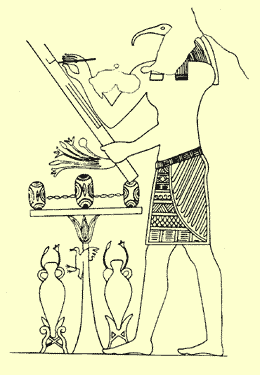The Tomb of the Crocodile at
Gebel (Jebel) al-Mawta in the Siwa Oasis
By Jimmy Dunn writing as Kelly Smith

The Tomb of the Crocodile is one of four notable tombs at Gebel al-Mawta, the Mountain of the Dead, in the Siwa Oasis of Egypt. The tomb was only discovered in October, 1940. It was thoroughly excavated in January of 1941 by Ahmed Fakhry. The tomb probably dates to the late Ptolemaic or early Roman Period. Some of the details of its scenes, particularly the offering tables, are comparable to those painted in the tomb of Si-Amun in the same necropolis. Unfortunately, the name of he owner is not preserved. The local Siwans gave it the name, "Tomb of the Crocodile", after it was cleared of debris and the paintings became visible.

The tomb is located on the northeastern corner of a terrace-like structure, and consists of three rooms, each coated with a layer of white plaster, and an entrance that opens to the east. However, though the walls were all prepared for decorations, only one room just inside the entrance has much in the way of adornment. The others were either left blank or their decorations were mostly destroyed.
The family which occupied the tomb cleared the burial chamber and the side chamber only because they reached them through a break in the rock from a neighboring tomb. When discovered, the decorated chamber, which is nearest to the entrance, was full of debris because the floor is four steps lower than the threshold.
Though interesting, this is not a remarkable tomb. The walls were coasted with a layer of poor quality plaster and the paintings were made by an unskilled hand. At the entrance to the decorated chamber are three figures, minus their heads, who hold knives in their hands to protect the body of the tomb owner. Originally there were four figures, and they were in all probability the four sons of Horus.
Within the chamber on the right hand side at the corner of the north wall, a seated Hathor is depicted. She holds three branches of a plant in her right hand while she pours water from a vase held in her left hand. Another vase hangs from her wrist.

In the middle of the wall is a niche, and below it is a stylized grape tree. To either side of the grape tree is a fox shown eating the grapes. One fox is blue and the other one is yellow.
To the right of the niche is depicted the tomb owner seated in a char. Behind him stands the ram headed god, Amun, holding a knife in each hand. The body of the god is colored blue, while that of the tomb owner is a light red. Beneath them is a mad adorned with stepped pyramidal designs painted blue or red, bordered with two yellow lines, and below this, a crocodile appears painted in yellow. The intersecting lines representing its scales are red.

To the left of the niche are two registers. The upper registers shows the tomb owner worshipping Osiris, while the lower one depicts two female deities protecting the sun-god, who is seated on a flower, with their wings. The final painting on this wall shows the tomb owner worshipping Osiris, who is sitting on a chair, with Isis standing behind him.
On the right and side of the thickness of the door leading to the burial chamber there is a very damaged figure of the tomb owner who appears as a bearded man with thick curly hair. On the south wall, other fragments of figures remain from a scene of the god Thoth in the presence of Osiris.

The entrance to the burial chamber, which contained religious scenes, was blocked up during antiquity, but this did not prevent the tomb robbers form entering it during ancient times. In doing so, they badly damaged the decorations. The south wall is only partly preserved. Here, the god Osiris sits inside a shrine with an offering table in front of him. Tied to the stem of the table is a live bird. Opposite the table facing Osiris is a standing Thoth, with an ibis head on a human body, writing on a palette. His body is colored yellow, while he wears an apron colored in rich tones of red and blue.
Ahmed Fakhry relates that the crocodile painting caused a great sensation among the inhabitants who flocked to see it when the tomb was cleaned, and to hear stories told by other locals who claimed to know all about crocodiles from their visits to the Cairo zoo:
"I was much amused by their descriptions. All agreed that one could swallow a man or a woman, but one character assured his listeners that it could swallow a loaded camel. As for length, their estimates varied from ten to a hundred metres! Some of them wanted to know the truth from me, but I refrained from saying anything which might spoil their fun."
It is probable that during the period when this tomb was built a cult to the crocodile god, Sobek, existed in the Siwa Oasis. This is not as strange as it might seem for this isolated Oasis in the Western Desert, for it had, at all periods during its history, a relations with the Fayoum where the crocodile god was most venerated.
Resources:
|
Title |
Author |
Date |
Publisher |
Reference Number |
|
Dictionary of Ancient Egypt, The |
Shaw, Ian; Nicholson, Paul |
1995 |
Harry N. Abrams, Inc., Publishers |
ISBN 0-8109-3225-3 |
|
Siwa Oasis |
Fakhry, Ahmed |
2004 |
American University of Cairo Press |
ISBN 977 424 123 1 |
|
Western Desert of Egypt, The |
Vivian, Cassandra |
2000 |
American University in Cairo Press, The |
ISBN 977 424 527 X |

